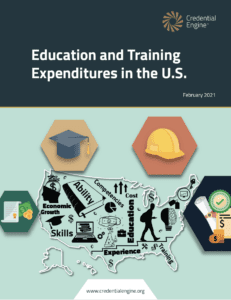
Notice: In 2022, Credential Engine updated this report. View it here.
Today, Credential Engine released two reports that offer unprecedented understanding of the credential landscape. The first report, Counting U.S. Postsecondary and Secondary Credentials, offers the most accurate and robust estimate of credentials across 16 categories—including both traditional degrees, certificates, certifications, licenses and apprenticeships as well as non-traditional offerings such as badges. The report estimates that there are 967,734 unique credentials in the United States, and offers a detailed state-by-state count of credentials. This finding shows what many already knew: the credential landscape is vast—perhaps much larger than many imagined.
The second report, Education and Training Expenditures in the U.S., gives the first national estimate of total yearly expenditures by educational institutions, employers, federal grant programs, states, and the military totaling $1.921 trillion. Unequivocally, expenditures on education and training are necessary to keep up with ever-changing workforce demands. But, two trillion dollars is nothing to take lightly. It underscores the seriousness of the credentialing marketplace while also signaling the need to create better processes for accountability and decision-making.
With nearly one million credential options and close to $2 trillion spent annually on education and training, it is important to put clear and reliable information in users’ hands. The current credential marketplace is confusing and causes many problems. The lack of transparent credential information and continued siloed nature of credential data has made it difficult for individuals, organizations, and education and training providers to adapt and get ahead. It is difficult to calculate a true return on investment when clear, relevant, consistent, and trustworthy credential information is clearly lacking. An unclear, siloed, and confusing credential landscape creates and perpetuates inequities by limiting who has access to which data and gatekeeping opportunity; all of which limits our ability to meet current and future education, workforce, and economic challenges.
“Employers and workers are scrambling after the economy faced unexpected and painful roadblocks amid a global pandemic,” says Scott Cheney, CEO of Credential Engine. “They shouldn’t have to guess which skills and credentials meet their needs—particularly with the proliferation of new options in this new normal. Painting a clear picture of the credential landscape is a critical first step in helping illuminate effective pathways back to economic security.”
These reports call for credential information to be made transparent as quickly as possible and put into the hands of workers, business leaders, and policymakers right now. Our ability to better meet the current and future economic and educational needs of the country depends on what we do with the information presented in these two reports. We all must do our piece as partners in transparency to create concrete pathways for people, states, education and training providers, businesses, and policymakers to have the credential information they need to make the best decisions.
We, and ten other organizations, have produced a State Roadmap and Action Guide to help advance states along this path. We are authoring a series of Policy Briefs to help stakeholder groups understand the benefits of credential transparency, including aligning state education and workforce data. Credential transparency allows everyone to better navigate the massive credential landscape, find real connections between education and work, and increase everyone’s return on investment; especially during this critical national push to jumpstart the economy.

